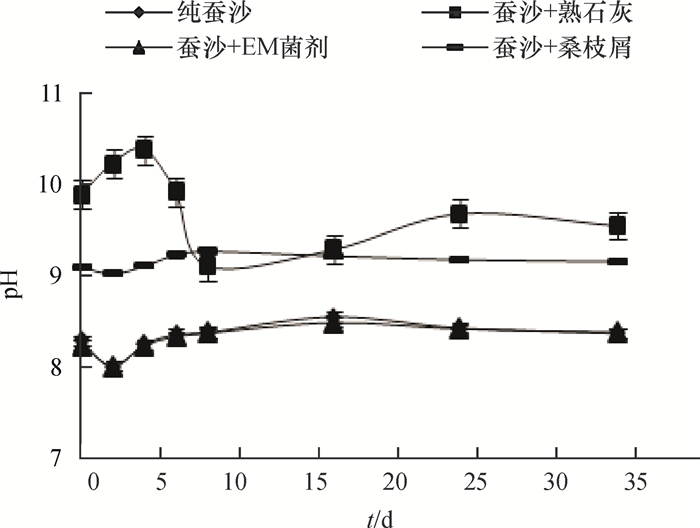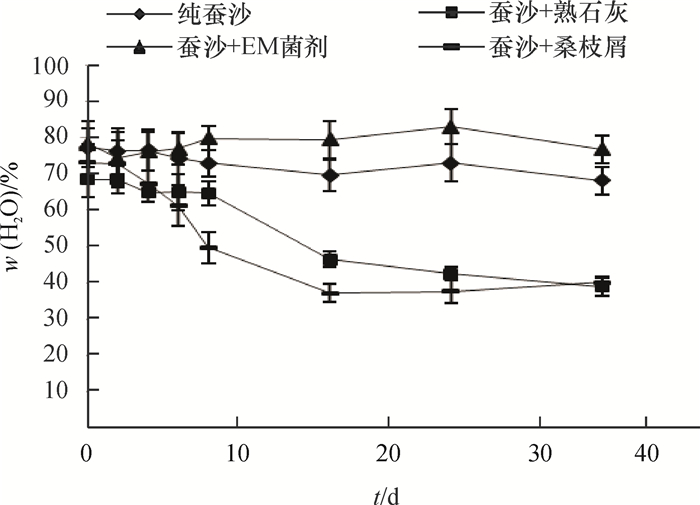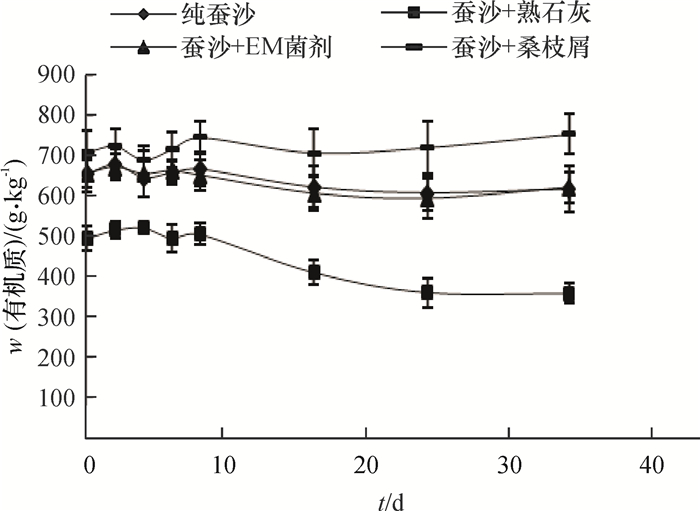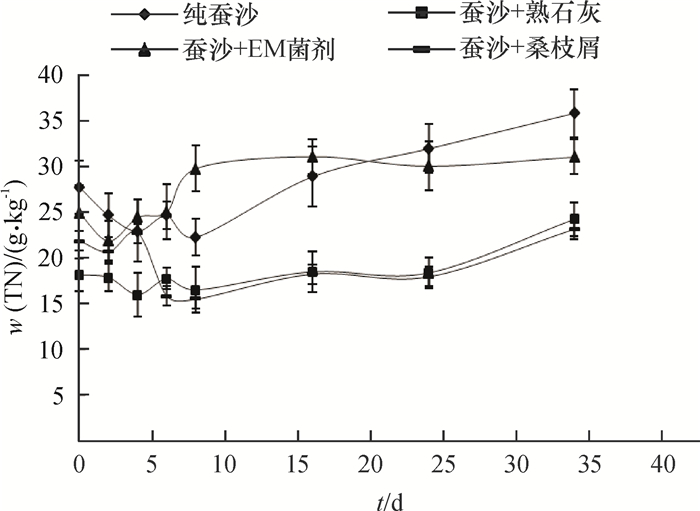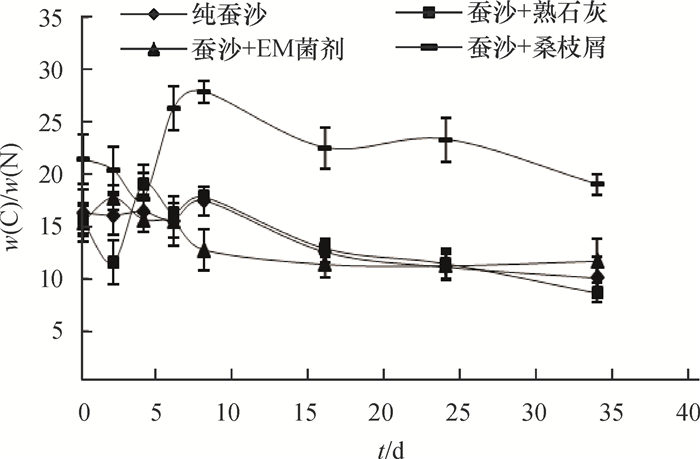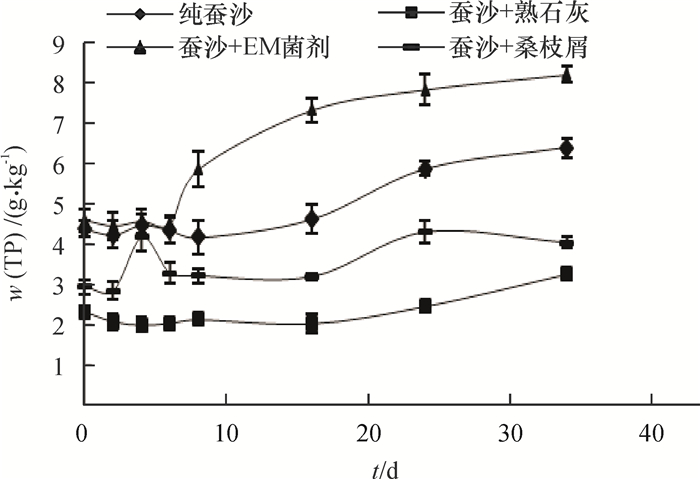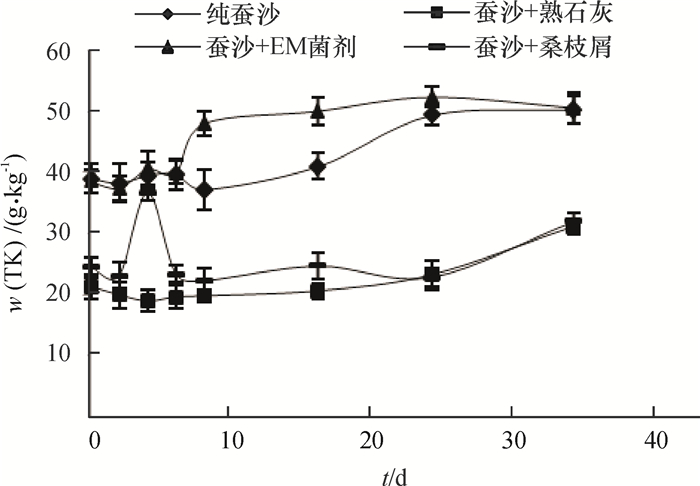Impacts of various materials on composting of silkworm excrement
-
摘要:目的
实现蚕沙的无害化处理和资源化利用。
方法以新鲜蚕沙为原料分别按质量比添加5.21%熟石灰、0.20% EM菌剂和10%桑枝屑,以未添加任何物质的新鲜蚕沙为对照,制定4种好氧堆肥体系,分析堆肥过程中的理化指标及微生物菌落数量的动态变化。
结果添加5.21%的熟石灰使堆体温度升至50 ℃的时间比对照推迟了5 d,堆体pH比有机肥标准高1.05,细菌菌落数减少,但有利于真菌和放线菌的繁殖,使堆体有机质含量下降、全氮量增加和含水率下降显著。添加0.20%EM菌剂,使全磷含量比对照增加了28%,有利于提高细菌菌落数,但真菌在堆肥中、后期的繁殖受影响,放线菌在整个堆肥期繁殖都受影响,其他指标的变化与对照差别不大。添加10%桑枝屑能使堆体含水率比对照降低40%,造成温度偏高而不利于真菌和放线菌的繁殖,其碳氮比的下降亦显著低于其他堆体,同时会造成堆体pH高0.66。4个堆体发芽指数均超过100%;堆体在50 ℃以上持续的时间均超过7 d。
结论经堆肥处理后,4个堆体均可以使蚕沙达到资源化利用的要求。
Abstract:ObjectiveTo acheive the innocuous treatment and resource utilization of silkworm excrement.
MethodFresh silkworm excrement pile was mixed with 5.21% hydrated lime, 0.20% EM agent, or 10% mulberry sawdust in mass fraction. The silkworm excrement pile without any addition served as the control. These four different aerobic composting systems were used for investigating the dynamic changes of physicochemical indexes and population of microbial flora during the composting process.
ResultThe treatment with 5.21% hydrated lime facilitated the reproduction of fungi and actinomycetes, decreased the organic matter content and the moisture content of the pile, increased the total nitrogen content of the pile, delayed 5 d before the temperature of the pile heating up to 50 ℃, resulted in 1.05 higher pH compared to the organic fertilizer standard, and decreased the number of bacterial colonies. The treatment with EM improved the total phosphorus content by 28%, which increased the number of bacterial colonies, but negatively affected the reproduction of fungi in the middle and later periods and the reproduction of actinomycetes throughout the composting process. No significant differences of other indicators were observed between the treatment with 0.20% EM and the control. The treatment with 10% mulberry sawdust reduced the moisture content by 40%, led to higher temperature which was disadvantageous for the reproduction of fungi and actinomycetes, and caused a significantly lower C/N ratio and 0.66 higher pH of the pile compared to other treatments. Germination indexes of four piles were above 100%, and all pile temperatures kept above 50 ℃ for more than 7 d.
ConclusionAll four piles of silkworm excrement can meet the demand of resource utilization after composting.
-
Keywords:
- silkworm excrement /
- composting /
- physicochemical index /
- microorganism
-
-
表 1 不同蚕沙堆肥下的种子发芽指数1)
Table 1 Seed germination indexes of different silkworm excrement piles

-
[1] 黄自然, 李树英.蚕业资源综合利用[M].北京:中国农业出版社, 2013: 73. [2] 刘桃李, 凌敏, 梁小双.蚕沙分步制取果胶和叶绿素锌钠盐[J].食品科技, 2013, 13(11): 255-258. http://cdmd.cnki.com.cn/Article/CDMD-10593-1014379682.htm [3] 张友胜, 纪平雄, 陈芳艳.用蚕粪生产高置换率叶绿素a锌钠盐的工艺条件初探[J].蚕业科学, 2007, 33 (2): 314-317. doi: 10.3969/j.issn.0257-4799.2007.02.030 [4] 陈芳艳, 钟杨生, 李文楚, 等.不同堆沤方式对蚕沙部分理化指标动态变化的影响[J].华南农业大学学报, 2013, 34(4): 598-601. http://xuebao.scau.edu.cn/zr/hnny_zr/ch/reader/view_abstract.aspx?flag=1&file_no=201304028&journal_id=hnny_zr [5] 潘澄, 贾仲伟, 张至庆.家蚕全龄人工饲料育试验初报[J].江苏蚕业, 2014, 36(4):13-15. doi: 10.3969/j.issn.1003-9848.2014.04.005 [6] LU D, WANG L X, YAN B X, et al. Speciation of Cu and Zn during composting of pig manure amended with rock phosphate[J]. Waste Manage, 2014, 34(8): 1529-1536. http://europepmc.org/abstract/med/24785363
[7] LI Y X, LIU B, ZHANG X L, et al. Effects of Cu exposure on enzyme activities and selection for microbial tolerances during swine-manure composting[J]. J Hazard Mater, 2015, 283: 512-518. http://cn.bing.com/academic/profile?id=ff2e93ec8e59a61d0838788afa6e7a8a&encoded=0&v=paper_preview&mkt=zh-cn
[8] ARIKAN O A, MULBRY W, RICE C. Management of antibiotic residues from agricultural sources: Use of composting to reduce chlortetracycline residues in beef manure from treated animals[J]. J Hazard Mater, 2009, 164(2/3):483-489. http://www.cabdirect.org/abstracts/20093104922.html
[9] BERNAL M P, ALBURQUERQUE J A, MORAL R. Composting of animal manures and chemical criteria for compost maturity assessment: A review[J]. Bioresour Technol, 2009, 100(22): 5444-5453. http://www.sciencedirect.com/science/article/pii/S0960852408009917
[10] LIU J, XU X H, LI H T, et al. Effect of microbiological inocula on chemical and physical properties and microbial community of cow manure compost[J]. Biomass Bioenerg, 2011, 35(8): 3433-3499. doi: 10.1016/j.biombioe.2011.03.042
[11] DE MENDONCÇA COSTA M S S, CESTONARO T, DE MENDONÇA COSTA L A, et al. Improving the nutrient content of sheep bedding compost by adding cattle manure[J]. J Clean Prod, 2015, 86: 9-14. http://www.sciencedirect.com/science/article/pii/S0959652614009160
[12] WANG K, LI X K, HE C, et al. Transformation of dissolved organic matters in swine, cow and chicken manures during composting[J]. Bioresour Technol, 2014, 168:222-228. http://www.ncbi.nlm.nih.gov/pubmed/24813566
[13] ACHIBAA W B, LAKHDARA A, GABTENIB N, et al. Accumulation and fractionation of trace metals in a Tunisian calcareous soil amended with farmyard manure and municipal solid waste compost[J]. J Hazard Mater, 2010, 176(1/2/3):99-108. http://cn.bing.com/academic/profile?id=59d2a465cb13e9e9a60156f369416e3e&encoded=0&v=paper_preview&mkt=zh-cn
[14] 陈晓萍, 谢亚军, 罗光恩, 等.蚕沙有机肥的养分特性及其肥效[J].应用生态学报, 2011, 22(7): 1803-1809. http://d.old.wanfangdata.com.cn/Periodical/yystxb201107021 [15] 叶柄, 丁桂芳. 森林土壤分析方法: LY/T1210~1275—1999[S]. 北京: 中国标准出版社, 2000. [16] 李阜棣, 喻子牛, 何绍江.农业微生物学实验技术[M].北京:中国农业出版社, 1996: 32-36. [17] 李国学, 张福锁.固体废物堆肥化与有机复混肥生产[M].北京:化学工业出版社, 2000. [18] 王绍文.固体废弃物资源化技术与应用[M].北京:冶金工业出版社, 2003: 6. [19] 刘卫星, 顾金刚, 姜瑞波, 等.有机固体废弃物堆肥的腐熟度评价指标[J].土壤肥料, 2005(3):3-7. doi: 10.3969/j.issn.1673-3908.2005.03.001 [20] DE BERTOLDI M, VALLINI G, PERA A. The biology of composting: A review[J]. Waste Manage Res, 1983, 1(1): 157-176. http://d.old.wanfangdata.com.cn/OAPaper/oai_pubmedcentral.nih.gov_1515433
[21] MILLER F C. Composting as a process based on the control of ecologically selective factors[C]// METTING F B, Jr. Soil microbial ecology, applications in agricultural and environmental management. New York: Marcel Dekker, Inc., 1992: 515-544.
[22] KEENER H M, DICK W A, HOITINK H A J. Composting and beneficial utilization of composted by-product materials[C] //DICK W A. Land application of agricultural, industrial, and municipal by-products. Madison: Soil Science Society of America, Inc., 2000: 315-341.
[23] 窦森, 王帅.不同微生物对形成不同腐殖质组分的差异性研究进展[J].吉林农业大学学报, 2011, 33(2):119-125. http://d.old.wanfangdata.com.cn/Periodical/jlnydxxb201102001 [24] 刘佳, 李婉, 许修宏, 等.接种纤维素降解菌对牛粪堆肥微生物群落的影响[J].环境科学, 2011, 32(10): 3073-3081. http://d.old.wanfangdata.com.cn/Periodical/hjkx201110043 [25] GODDEN B, BALL A S, HELVENSTEIN P, et al.Towards elucidation of the lignin degradation pathway in actinomycetes[J]. J Gen Microbiol, 1992, 138: 2441-2448. http://www.cabdirect.org/abstracts/19931378042.html
[26] BIBOLLET X, BOSC N, MATULOVA M.et al. 13C and 1H NMR study of cellulose metabolism by Fibrobacter succinogenes S85[J]. J Biotechnol, 2000, 77(1): 37-47. doi: 10.1016/S0168-1656(99)00206-0
[27] 胡明勇, 刘强, 陈雄鹰, 等.两种钙化合物在猪粪-稻草堆肥中除臭及保氮效果研究[J].湖南农业科学, 2009(7): 51-54. doi: 10.3969/j.issn.1006-060X.2009.07.018 [28] WITTER E, KIRCHMANN H. Peat, zeolite and loasalt as adsorbents of ammoniacal nitrogen during manure decomposition[J]. Plant Soil, 1989, 115(1):43-52. doi: 10.1007/BF02220693
[29] 赵明梅, 牛明芬, 何随成, 等.不同微生物菌剂对牛粪堆肥发酵影响的研究[J].农业环境科学学报, 2007, 26 (增刊):587-590. http://d.old.wanfangdata.com.cn/Conference/6389586



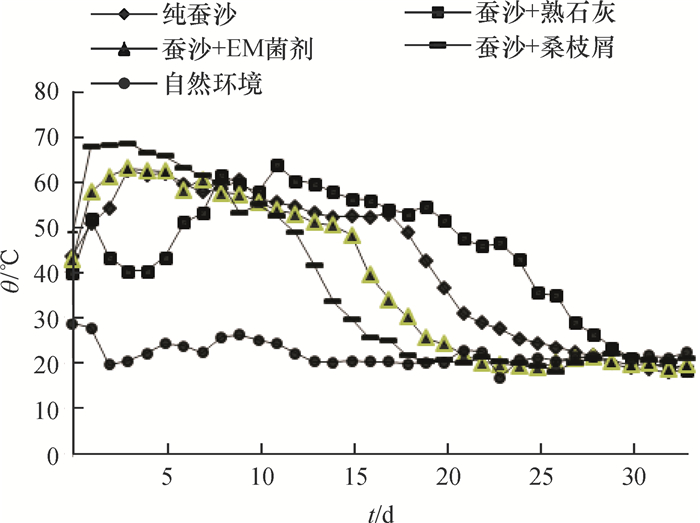
 下载:
下载:
